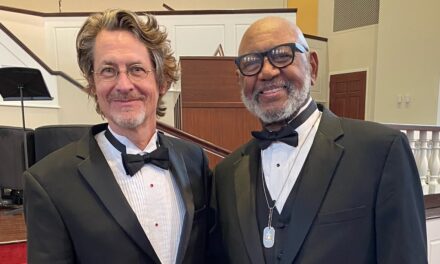After Hubbard Street Dance Chicago’s riveting 2004 American Dance Festival performance, expectations were high for the company’s appearance this year. HSDC’s powerful dancers have highly developed abilities of interpretation. They can take on pieces by a wide range of the world’s best choreographers, to any music, and this year’s program indicated that once again they would offer a fine smorgasbord. The last of HSDC’s three performances in Page Auditorium had its share of greatness, but it started with a disappointment.
“Petite Mort” (“Small Death,” or “orgasm”), a 1991 dance by Jirí Kylián for five men and five women, started the evening. Set to the adagio from Mozart’s Piano Concerto No. 23 in A Major, K.488, and the andante from his Piano Concerto No. 21 in C Major, K.467, it is based on the idea of soldiers, their rapiers intact, returning victorious from war to “die” in their lovers’ arms. The dancers wore remarkably ugly costumes designed to look like corsets and high-waisted underwear, and the lighting was unfriendly. The choreographer has managed to strip the romance from this concept, and the piece was surprisingly passionless and a little bit tawdry — anti-erotic. The first section with its flaccid swordplay was especially weak. Fortunately, the Hubbard Street dancers’ famed musicality shone through in elegant movements, and the music is beautiful.
“Kiss,” an aerial duet from 1987 by Susan Marshall, set to music by Arvo Pärt, was far more satisfying. Too often dances using aerial devices feel as if the choreographer had just been casting about for something fun to do with the ropes and harnesses. Here it seems she had asked instead, how can I best express the feelings of new passionate love? Their feet never touching the ground, Cheryl Mann and Tobin Del Cuore conveyed all the swooping, twirling, tangling, tumbling thrills of two bodies whose souls have twined.
After the first intermission came the delightful romp of Twyla Tharp’s “Baker’s Dozen,” set to tunes by Willie “The Lion” Smith. Choreographed in 1979 and first performed by HSDC in 1990, this piece has staying power. Not only is it rich in dancing, it is cheerfully entertaining. All twelve dancers are in white (costume design by Santo Loquasto), and they flow on and off the stage in shimmering ripples and tides of motion. At moments you could easily forget you were at ADF and think you were seeing a Broadway show. There wasn’t a shadow on its pleasing surface (lighting design by Jennifer Tipton), and happy laughter accompanied its playful frolics.
Shadows were included in a recent piece by young Spanish HSDC dancer and choreographer Alejandro Cerrudo. Many of them were supplied by the smoky sounds of singer-songwriter Devendra Barnhart, although Cerrudo added some of his own to his generally playful and humorous look at young people looking for love. There are some fine sequences here and lots of rich detail in the movement. It was particularly refreshing after the older pieces that had preceded it. The HSDC is celebrating its 30th birthday this year, an event notorious for the backward-looking evaluations it provokes, and the ADF is marking its 30th year in Durham with an emphasis on re-presenting older dances. Seeing the art of now is what makes the ADF such a powerful experience each year, and to see it juxtaposed with work decades older allows you to understand even more clearly how the zeitgeist has changed.
The two previous evenings had closed with a new work by company artistic director Jim Vincent (which had not been very well received), but on the 30th, Nacho Duato’s “Gnawa” was substituted. This ravishing dance was set on HSDC by the choreographer in 2005, and Duato exploited these dancers’ strengths in gesture, spacing and density to amplify his gorgeous movement vocabulary. It is set to a long list of music from Spain and North Africa, and is as beautiful as illuminated Arabic calligraphy — to which it owes much of its grace and force of line and angle. Duato has an uncanny way with conjuring images outside of any explicable narrative. Here we saw so many, each dissolving into another more entrancing. The bodies writing their unknown words; mosques; the sea; the desert at night; tiny cantinas and markets in port towns; arches and passageways and those who come and go in spiritual seeking. Massing together and spacing apart, the dancers’ bodies pulse the life of a place that may only exist in our collective imagination but will live there forever.












